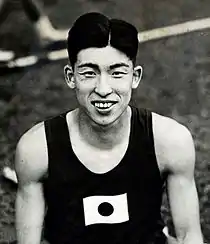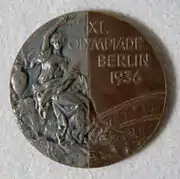Shuhei Nishida
Shuhei Nishida (西田 修平, Nishida Shūhei, May 21, 1910 – April 13, 1997) was a Japanese Olympic athlete who competed mainly in the pole vault.[1]
 | |
| Personal information | |
|---|---|
| Native name | 西田 修平 |
| Nationality | Japan |
| Born | May 21, 1910 Nachikatsuura, Wakayama, Japan |
| Died | April 13, 1997 (aged 86). Tokyo, Japan |
| Alma mater | Waseda University |
| Height | 1.76 m (5 ft 9 in) |
| Weight | 61 kg (134 lb) |
| Sport | |
| Sport | Athletics |
| Event(s) | Pole vault |
Medal record
| |
Nishida was born in what is now part of Nachikatsuura, Wakayama Prefecture, Japan. He was a student of the Engineering Department at Waseda University, when selected as a member of the Japanese Olympic team for the 1932 Summer Olympics in Los Angeles, where he won the silver medal in the pole vault event.[1]


After graduation from Waseda University, he obtained a job at Hitachi. He subsequently participated in the 1936 Summer Olympics held in Berlin, Germany where he repeated his performance winning a second silver medal in the same event tying with his friend and teammate Sueo Oe. When the two declined to compete against each other to decide a winner, Nishida was awarded the silver and Oe the bronze by decision of the Japanese team, on the basis that Nishida had cleared the height in fewer attempts.[2] The competition was featured in a scene in the documentary Olympia, filmed by Leni Riefenstahl. On their return to Japan, Nishida and Oe famously had their Olympic medals cut in half, and had a jeweler splice together two new “friendship medals”, half in bronze and half in silver.[1][3][4]
At the age of 41, Nishida won a bronze medal at the 1951 Asian Games. He remained active in sports all of his life, serving as a referee at events, and from 1959 as an honorary vice chairman of the Japan Association of Athletics Federations, and as a member of the Japanese Olympic Committee. In 1989, he was awarded the silver medal of the Olympic Order. Nishida died of heart failure in 1997 at the age of 87.[1]
References
- Shuhei Nishida. sports-reference.com
- https://www.independent.co.uk/sport/olympics/rio-2016-olympics-shuhei-nishida-and-sueo-oe-berlin-1936-japan-the-friends-who-wouldn-t-be-divided-7166816.html
- "The Olympians who took matters into their own hands when they weren't allowed to share their medal". The Independent. 2016-08-05. Retrieved 2020-01-01.
- "Shuhei NISHIDA". Olympic Channel. Retrieved 2020-01-01.
Further reading
| Wikimedia Commons has media related to Shuhei Nishida. |
